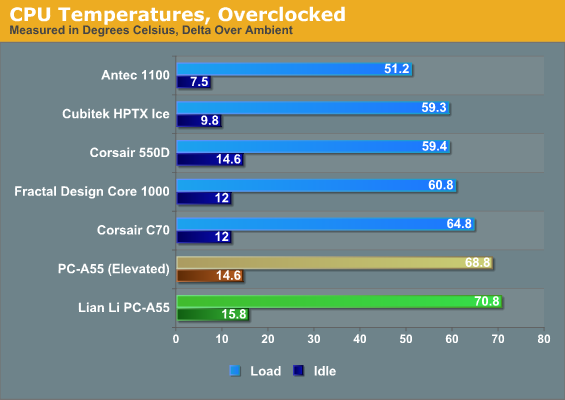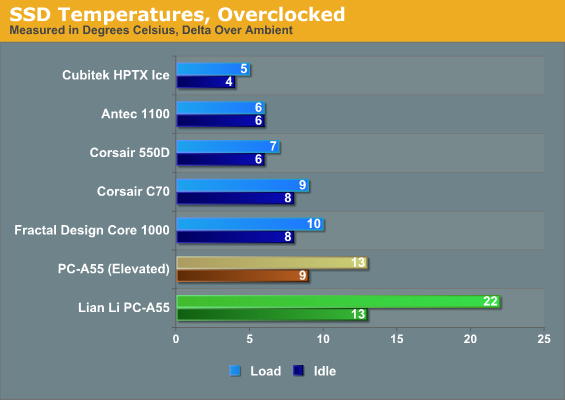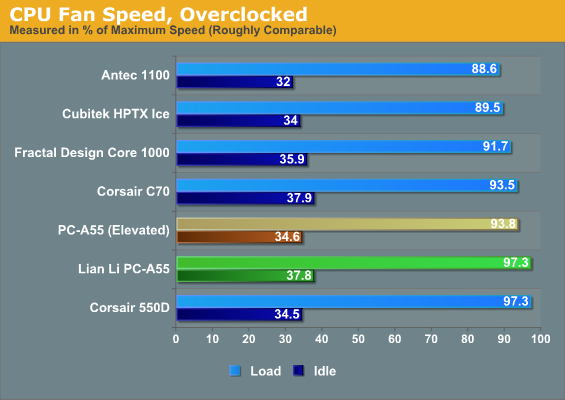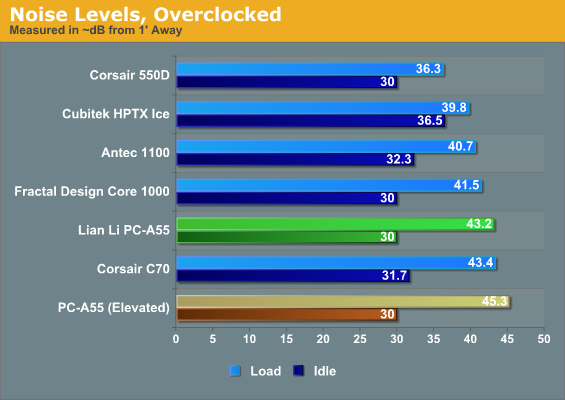Lian Li PC-A55 Case Review: Unfortunate Name Befits the Design
by Dustin Sklavos on June 16, 2012 12:30 PM EST- Posted in
- Cases/Cooling/PSUs
- mid-tower
- Lian Li
- ATX
Noise and Thermal Testing, Overclocked
Lian Li's PC-A55 is the first time I've actually been nervous about thermally testing a case. The CPU cores were already pushing the mid-to-high 80s at stock settings under load; how was this whole thing going to fare when I bumped up the clocks and pumped more voltage through the CPU and graphics card? As it turns out, it wasn't going to fare well at all, and I'm thankful we live in an era where our hardware has thermal protections in place. Ten years ago, I likely would've had to replace most of the testbed after this.



On the charts it doesn't look as bad, but keep in mind that the Intel Core i7-2700K's cores were actually hitting 95C with the case elevated, and 98C without. The GeForce GTX 560 Ti was also peaking at 95C. All of this in a room with an ambient temperature of about 24C, a temperature which isn't terribly uncomfortable or unreasonable. If the PC-A55 had a hard time dealing with a stock system, it flat out couldn't deal with any kind of overclocking. What's worse, look at how heat builds up around the SSD and imagine what would happen if a mechanical drive were used.


Our Cooler Master Hyper 212 Evo was being pushed as hard as it possibly could and the CPU thermals were still hitting the maximum spec. The normally efficient custom cooler on the ASUS GeForce GTX 560 Ti had just as hard a time, with the fan basically maxing out under load. Lian Li's design has virtually no thermal headroom. With the elevated testbed, the GPU does better, but even so it places last out of our set of cases.

The PC-A55 basically winds up being our worst-case scenario on almost all fronts. While it remains quiet at idle, under load it's very noisy and uncomfortable to listen to, due to the fact that the fans running inside are all going at full bore. As a side note, because of the aluminum shell, the top of the case was actually almost painfully hot to the touch when tested under these conditions. Putting the case on a flat surface helped thermals a bit, but also gave noise one more place to escape, causing it to run even louder.










64 Comments
View All Comments
Dustin Sklavos - Sunday, June 17, 2012 - link
Considering the mountain of cheap laughs I got working on this review, I'm happy to disappoint you.eBob - Saturday, June 16, 2012 - link
My current case is full ATX and is smaller than that! I was actually considering going micro-ATX for my next build, but couldn't find a motherboard that I liked.crackedwiseman - Saturday, June 16, 2012 - link
A couple of years ago I did a build for a customer in an A05, which, similarly to the A55, tries to fit an ATX board in an mATX sized enclosure. It was a bit cramped, but not that bad, and thermal performance was solid given that I had an overclocked i7-920 and a GTX 260 in there. The A05 had a totally different internal layout; I can't image why they decided to change it - this is anything but an improvementrickcain2320 - Thursday, June 21, 2012 - link
The A05 doesn't work well unless you cut a hole in the top or add a slot fan. I never kept the front panel on because of heating concerns, which turned out to be true as my motherboard chipset fried from the heat, taking out the video card in the process.PortsOrBust - Sunday, June 17, 2012 - link
"Unfortunately, a case I can't find any argument for."This thought may be anathema on a "latest and greatest" enthusiast site, but if one simply wanted a small ATX case, and used only on-board ports with no additional cards, it seems to me that most of the other issues are not deal-killers.
Granted the PSU mount isn't ideal, but without add-in cards the airflow would likely overcome that problem, and finding a way to raise the box off the floor a half an inch or so isn't a big deal either.
Some people will pay $110 for the size and looks of a case, but aren't looking to spend $400 on the latest and greatest video card.
So, its by no means a perfect case, or even the best example of a compact case, but that doesn't mean there's no argument for it . . .
Dustin Sklavos - Sunday, June 17, 2012 - link
Except if you're not going to use any expansion cards, what's the point of going with a full ATX board instead of Micro-ATX or even Mini-ITX?erwendigo - Monday, June 18, 2012 - link
The better quality of a good ATX motherboard, a very "little" point.This review is a shame. You lost the point of a minimal case ATX, you had overestimate the importance of temperatures in a system that it isn´t in the enthusiast niche.
This case have a very specific niche, but you missundertood this and its rol.
And the worse, you made a lot of badass jokes. :-/
plamengv - Sunday, June 17, 2012 - link
Lian Li PC-A55 compared to Antec NSK-4000 is a monster. Lian Li never had such a good case as Antec is!Alchemy69 - Sunday, June 17, 2012 - link
This will do until NZXT release their M0-U7H case and then I'll go from A55 to M0-U7H.dave1_nyc - Sunday, June 17, 2012 - link
I'll probably wind up feeling like a dumbass for saying this, but I can' t believe that the dimensions are correct, esp the height, which is shown as 17.6". One of my machines systems uses a Fractal R3, which feels far more spacious, (and which has room for the PSU under the ATX slots), and it's about the same height.It measures a little bit higher from the floor, but then it has taller feet, and hence more space under the case for air intake.
So what am I missing? How can this case be almost 18" high and yet have so little vertical space?